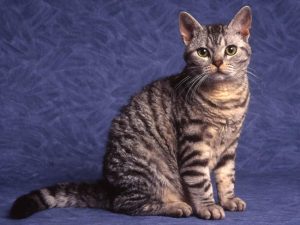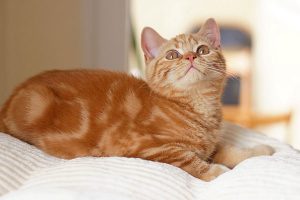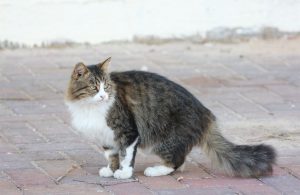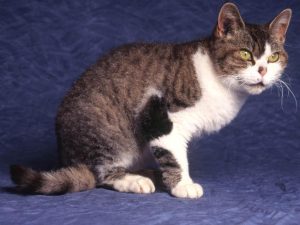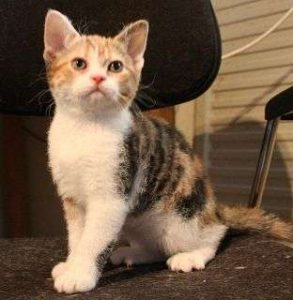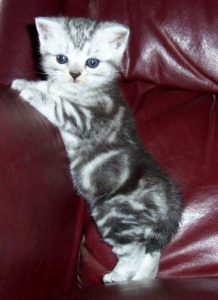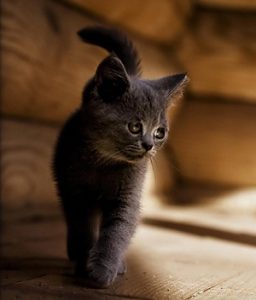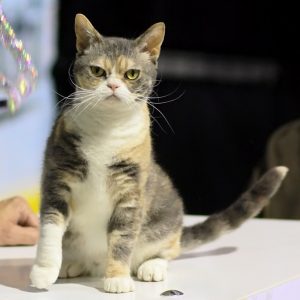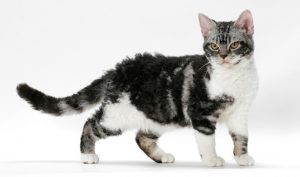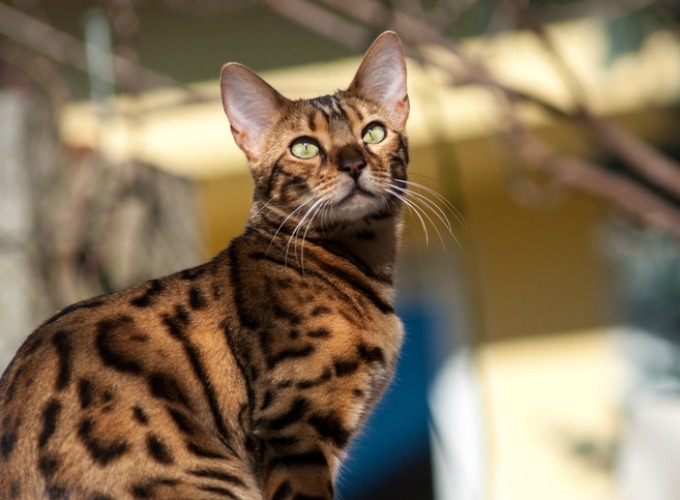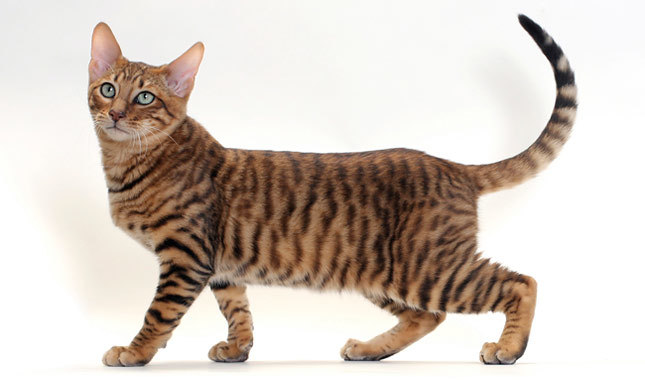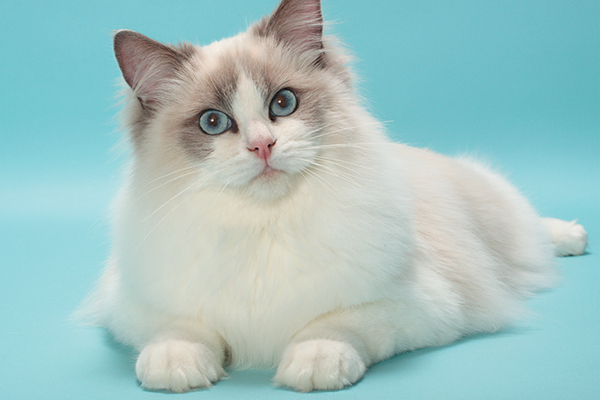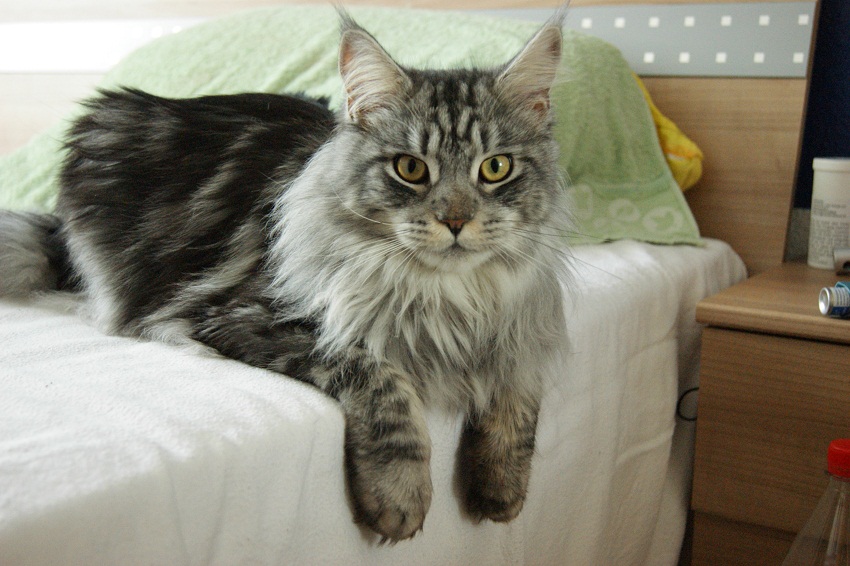The American Wirehair is a medium-sized domesticated breed of cat with a muscular, well-balanced structure. This breed is considered as the rarest breed out of the 41 cats of the Cat Fanciers’ Association, as of 2003. The Wirehair is a natural mutation of the American Shorthair cat. This cat has a springy, hard coat, with short legs and tail, firm muzzle and chin, and distinct cheekbones. Their face is round with large eyes. The distinguishable characteristic of these cats is that their body hair and the whiskers are hooked, bent or crimped.
Quick Information
Physical Appearance & Size
| Weight | 12 – 15 pounds |
Colors & Patterns
Other Characteristics
| Life Expectancy (Lifespan) | 15 to 16 years |
| Weight | 12 – 15 pounds |
| Litter Size | 6 kittens (average) |
| Personality Traits | Gentle, quiet, social, patient, playful |
| Shedding | Average |
| Good with Children | Yes (over six years) |
| Hypoallergenic | No |
| Vocalization | Less, low |
| Country of Origin | USA |
| Competitive Registration/Qualification Information | TICA, ACFA/CAA, CFA, CCA |
History
In 1966, in Vernon, upstate New York, the American Wirehaired cat appeared for the first time to a pair of barn cats in a litter of five, by spontaneous mutation. This single male had a red-and-white wiry coat hair.
The owner of the cats wanted the advice of a local Rex Cat breeder Mrs. Joan O’Shea, who bought the male for $50, along with one of the four female. O’Shea arranged for a breeding program between the two, and the two cats gave birth to more wirehaired kittens. She sold off the kittens to more breeders, and thus the population went on.
Soon after, more cats were exported to Germany and Canada, where they are specifically well-known. The breed soon gained popularity, and in 1967, it got recognition from the CFA. It was allowed for the first time to appear for championship competition in 1978.
Temperament and Personality
Described as cute and funny, these cats share almost a common demeanor with its close relative – the American Shorthair. They love human company, including visitors, but are independent.
Although calm, polite and quiet by temperament, the AWH is a patron of playtime. They enjoy spending time playing with children even when they grow old. These lap cats have a very low voice and would rather prefer staying indoors or sleep on the owners’ laps. They are also good for multi-pet households.
They are intelligent and are curious about everything going on around. They might display their hunting skills when they find an insect trespassed into its house, or would also enjoy watching birds hopping outside its window. The females of the breed are more busy and active, while the males are much casual and easy-going.
Care
Interestingly, these cats need extremely less grooming. In fact, the more you would brush it, more will its coat hair tend to be damaged, and more will it shed. Hence, unless your cat’s natural heavy shedding cycle begins during springtime (shedding season), leave it alone. Your cat will also shed if it is too much stressed.
Though, sometimes, your cat does need a bathing session. This is mostly because its skin is oily. Get your cat accustomed to the pleasant side of bathing when it’s still a kitten.
The AWH is generally a healthy breed. But because it is often bred with the American short, it often picks up the genetic diseases of that breed, e.g. the heart disease HCM (hypertrophic cardiomyopathy), which is very common to the AWH. Hence, it is advisable to screen your kitten for HCM before you adopt it.
Also, because of its oily skin type, the AWH is prone to develop skin problems.
Training
The training part is as simple as other general cat breeds. Socialize your cat from an early age. Train your pet the basics of living with its human family, and the personal etiquettes of your household that your pet needs to learn.
Diet/Feeding
There are no special dietary needs for the American Wirehaired cat. Stick to the basic feline dietary rules for feeding your American Wirehaired.
Interesting Facts
- The wire-haired cats are available in up to 27 different color variations and patterns.
- The first American Wirehair was named Adam, while its female partner and litter mate (not an AWH) was named Tip-Top.
- This breed is yet to make an appearance in Australia and UK, among a few other countries.
- The first wire-haired kitten Adam and its female litter mate were the lucky survivors from a weasel attack.
- Like its coat, the whiskers of these cats are also springy.
- These cats are also comfortable with pet dogs in their homes.
- The extremely rare American Wirehair is actually a spontaneous mutation of the American Shorthair.

